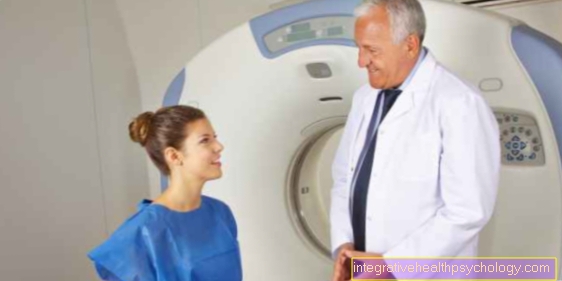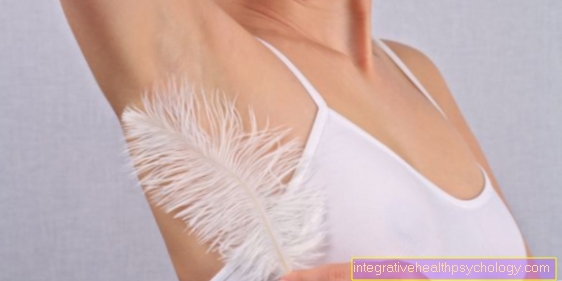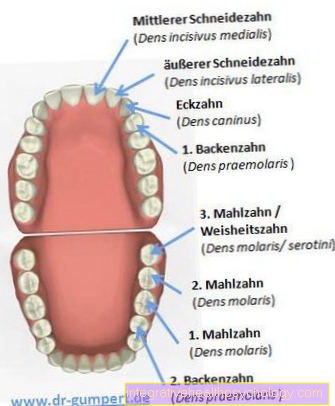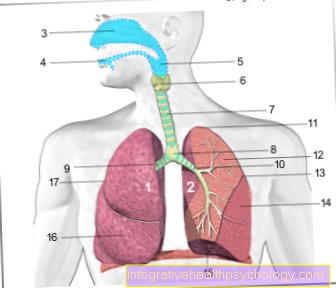brain
synonym
lat .: cerebrum, Greek: Encephalon, engl .: Brain
definition
The brain is the most important organ of vertebrates and forms the overriding command center of the central nervous system and regulates all conscious and unconscious functions and processes. The brain is also the most highly developed organ of the vertebrates, because its large number of networked neurons (19-23 billion in humans) is able to process and evaluate complex information content and to adapt a physical reaction to this content (behavior).
Last but not least, the brain is able to store and retrieve experiences and memories. The simplest processes of the Central nervous system are interconnected in so-called reflex paths. These have the advantage that they can process information comparatively quickly and do not first have to be perceived via the cerebral cortex. These include, for example, the regulation of Heart rate, breathing, Pupillary reaction and of course the Patellar tendon reflex, which is mandatory in the reflex test. These reflexes form the basis of the innate defense reactions and enable the organism to adapt quickly to its environment. For example, if the light is too strong, the pupils are narrowed in order to reduce the light falling on the retina.
Last but not least, the ability to learn and to apply learned content, or to be able to evaluate and apply it, certainly form some of the most noteworthy cognitive functions of the brain. Biologically, that's changing brain constantly and constantly forming new links between Neurons so that, roughly speaking, at the end of the day we have a “different” brain than the one we woke up with. This means that with every new connection that is created between our nerve cells, a potential new information path arises, via the new and old content can be processed. This ability to absorb, process and apply information makes the human brain the most complex organ we know. The spectrum of the functions of the brain thus range from simplified reflex programs (which every lower living being has) and innate behaviors to highly developed cognitive processes such as thinking and learning.
Illustration brain
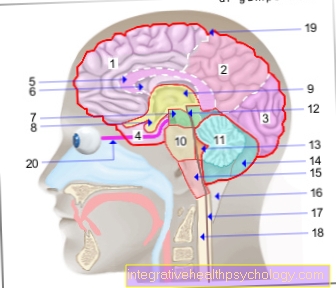
Cerebrum (1st - 6th) = endbrain -
Telencephalon (Cerembrum)
- Frontal lobe - Frontal lobe
- Parietal lobe - Parietal lobe
- Occipital lobe -
Occipital lobe - Temporal lobe -
Temporal lobe - Bar - Corpus callosum
- Lateral ventricle -
Lateral ventricle - Midbrain - Mesencephalon
Diencephalon (8th and 9th) -
Diencephalon - Pituitary gland - Hypophysis
- Third ventricle -
Ventriculus tertius - Bridge - Pons
- Cerebellum - Cerebellum
- Midbrain aquifer -
Aqueductus mesencephali - Fourth ventricle - Ventriculus quartus
- Cerebellar hemisphere - Hemispherium cerebelli
- Elongated Mark -
Myelencephalon (Medulla oblongata) - Big cistern -
Cisterna cerebellomedullaris posterior - Central canal (of the spinal cord) -
Central canal - Spinal cord - Medulla spinalis
- External cerebral water space -
Subarachnoid space
(leptomeningeum) - Optic nerve - Optic nerve
Forebrain (Prosencephalon)
= Cerebrum + diencephalon
(1.-6. + 8.-9.)
Hindbrain (Metencephalon)
= Bridge + cerebellum (10th + 11th)
Hindbrain (Rhombencephalon)
= Bridge + cerebellum + elongated medulla
(10. + 11. + 15)
Brain stem (Truncus encephali)
= Midbrain + bridge + elongated medulla
(7. + 10. + 15.)
You can find an overview of all Dr-Gumpert images at: medical illustrations
anatomy
The human brain can be divided into 2 halves of the brain, so-called hemispheres. It weighs between 1245 and 1372 grams (in humans) and consists of almost 23 billion nerve cells and intercellular tissue. The brain is covered by the brain skull (so-called neurocranium) and is separated from the so-called facial skull (viscerocranium). The brain swims in the cerebrospinal fluid, also called liquor, which is formed by the choroid plexus. It serves as a nourishing medium and as a protection against movements of the brain within the skull. The brain is also surrounded by the meninges, which also have a protective and nutritional function. The so-called gyry and sulci (windings and valleys) can be seen on the surface of the brain. These enlarge the surface of the brain so that several nerve cells fit into the same space, namely the skull. As a result, the performance of the brain could be increased without the skull having to grow with it to a large extent. The brain can be superficially divided into different lobes, some of which form neuroanatomical as well as functional boundaries. These include the frontal lobe (frontal lobe), the parietal lobe (parietal lobe), the occipital lobe (occipital lobe) and the temporal lobe (temple lobe). Important functional centers of the central nervous system such as the speech and sensory center (parietal lobe), the hearing center and the seat of the primal instincts or feelings (temporal lobes) and the visual center, which is located in the occipital lobe, are located in these lobe areas. In the frontal lobe there are motor centers, higher cognitive centers (thinking, decision-making), the seat of behavior and the feeling of drive ("development of an idea"). The complex cooperation of these centers with one another and the ability to think and plan as individuals distinguish humans from other vertebrates. These special abilities are of course also reflected in the rough anatomy of the brains of different vertebrates. The brains differ in size and shape and in many cases are also adapted to special tasks. The olfactory center and the hearing center are particularly strong in dogs, for example, and are many times more sensitive than the human senses. Every species, no matter how advanced it is, has to survive in nature through special abilities. These can also be of a physical nature. However, the further development of the senses, which ultimately enable communication with the environment, is an important process and ultimately a part of natural evolution.
structure
That is structured brain is in several brain sections:
- Endbrain = Telencephalon
- Diencephalon = Diencephalon
- Brain stem = Truncus encephali
To the Brain stem belong:
- Midbrain = Mesencephalon
- Afterbrain = Metencephalon from bridge (Pons) and Cerebellum
- Extended mark = Medulla oblongata
The End- and diencephalon of the brain together form that Forebrain (Prosencephalon), the former from the Cerebral cortex (Cortex), den Basal ganglia and the limbic system consists. The latter includes the structures thalamus, epi-, sub- and hypothalamus as well as metathalamus.
Of the Brain stem des Gehrins is in Midbrain, Afterbrain such as extended mark divided. The midbrain is made up of the Four-hill plate (Tectum), the Midbrain hood (Tegmentum) and the Cerebral legs (Crura cerebri) together.
The Afterbrain includes that Cerebellum (Cerebellum) and the bridge (Pons). Alternatively, the bridge, cerebellum, and elongated medulla can also be called Hindbrain (Rhombencephalon) are grouped together.
If the brain is intact, the endbrain, the cerebellum on the back and the posterior brain can be seen from the outside. The endbrain is divided lengthways into two equal parts, the cerebral hemispheres, by a noticeable, central furrow. Regarding the position, the endbrain and diencephalon are to be found in the anterior and middle cranial fossa, the brain stem - especially the cerebellum - on the other hand in the posterior cranial fossa. The medulla oblongata as the structure of the brain continues seamlessly into the spinal cord.
Inside the brain encloses spaces, which with Nerve water (Liquor cerebrospinalis) are filled and form a coherent ventricular system. Their job is to protect the brain from vibrations.
Blood supply to the brain
The Blood supply to the brain can in the front and posterior circulation to be grouped.
Of the anterior circulation of the brain is from the right and left Carotid artery (Common carotid artery) fed. The inner carotid artery branches off from this (Internal carotid artery), which in turn gives off two vessels that draw to the brain: Arterria cerebri anterior (anterior cerebral artery) and Media cerebral artery (middle cerebral artery). The lateral part (Anterior cerebral artery) or the middle part (Posterior cerebral artery) of the cerebral hemispheres. All of the above-mentioned vessels supplying the brain exist in duplicate, since they are placed on both the left and right sides of the body.
Of the posterior circulation of the brain forms from the two vertebral arteries (Vertebral artery), which become the unpaired basilar artery (Basilar artery) unite. In its course to the brain, this gives off several branches to supply the brain stem and finally ends as a posterior cerebral artery (Posterior cerebral artery), which the posterior parts of the endbrain and partly the diencephalon with blood provided. Also these are vessels of the brain created twiceThe exception is the basilar artery, which only exists once.
Between the three cerebral arteries there are smaller connecting vessels (Collaterals) a coherent vascular system, the Circulus arteriosus cerebri Willisii ("Willisi arterial cerebral circulation"). Such a system is called an anastomosis system (anastomosis = network-like vascular connection) due to the connections between them.
Cerebrum
The Cerebral cortex From a developmental point of view, (cortex) forms the newest part of the brain.
This is where complex processes such as:
- language
- motor processes
- differentiated sensors (Tactile sensation, pressure sensation, pain ...)
and - Sensations
processed, compared with other information and responded to these sensations with a specific reaction (motor centers). Other functions like memory, thinking, learning even feelings are all part of the benefits Cerebrum.
The deeper parts of the cerebrum, the so-called cerebral nuclei, represent important switching points for motor and sensory stimuli.
For more information, see: Cerebrum
Diencephalon
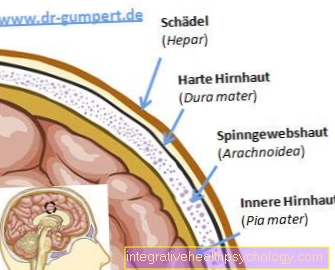
The diencephalon is responsible for the hormonal regulation of the body, for important autonomous processes (unconscious functions) and is also the switching point for stimuli from the environment that are called into consciousness by the cerebral cortex ("Gateway to Consciousness"). Hormones regulate a variety of processes in the body such as metabolism, growth and reproduction. The most important hormone-regulating system is the hypothalamic-pituitary (pituitary gland) axis. This axis is responsible for ensuring that important growth and reproductive impulses reach the body and can develop their effect there. Important representatives here are the thyroid hormone, growth hormone and sex hormones. In addition, the diencephalon regulates our biorhythm, our eating and drinking behavior (hunger and thirst) and our sexuality.
For more information, see: Diencephalon
Midbrain
The midbrain represents the place in the brain where important central nervous reflexes are activated and switched. There are also important centers here that modulate and coordinate motor programs with the help of messenger substances (neurotransmitters). This is where dopamine plays an important role. In some people, the production of dopamine is disturbed and gross motor skills are defective (Parkinson's disease). Furthermore, in the midbrain and then in the extended spinal cord, the regulatory centers for autonomous processes such as breathing, the cardiovascular system and blood pressure regulation are located. The midbrain also receives motor information from the periphery in order to synchronize it with the motor programs that are developed in the brain in order to generate uniform movements together with the cerebellum.
Also read our main article: The Midbrain
Cerebellum
The cerebellum forms a special instance of the brain and is mainly concerned with the modulation, regulation and coordination of motor impulses and stimuli in the body. The task of the cerebellum, together with the organ of equilibrium, is to maintain equilibrium and to coordinate muscle tone. As with computers, information from different parts of the brain is fed into the cerebellum, processed and recalculated. Thus, a targeted motor action can arise. Last but not least, the cerebellum is assigned its own motor “memory”, where certain frequently used motor programs are stored.
For more information, see: Cerebellum
Medulla oblongata
The elongated spinal cord (medulla oblongata) forms the continuation of the midbrain and also contains important parts of central nervous reflex pathways. Most of the so-called cranial nerve nuclei are also located in the extended spinal cord. Cranial nerves are peripheral nerves that arise directly from the brain and perform a variety of different tasks. The nuclei of the associated cranial nerves consist of a collection of nerve cells that specialize in the specific task of the nerve and are mainly located in the elongated spinal cord. Parts of the autonomous regulatory centers for breathing and the circulatory system are also located in the elongated spinal cord, so that injuries that occur here are often incompatible with life.
For more information, see: medulla oblongata
Summary
In summary, the brain is the most important superordinate instance of our organism. A large number of processes are regulated and carried out here, which enable interaction with the environment. The brain also takes control of important physical processes that influence the growth and development of the organism. The brain is not least the seat of personality, feelings and thoughts and thus forms one of the greatest secrets of science.





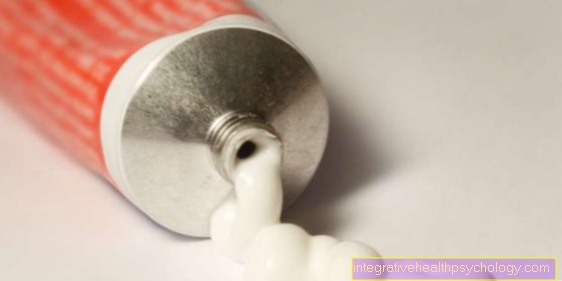


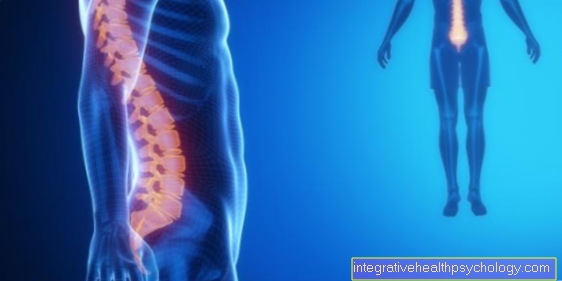
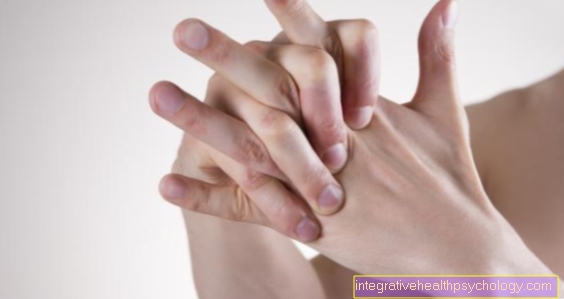

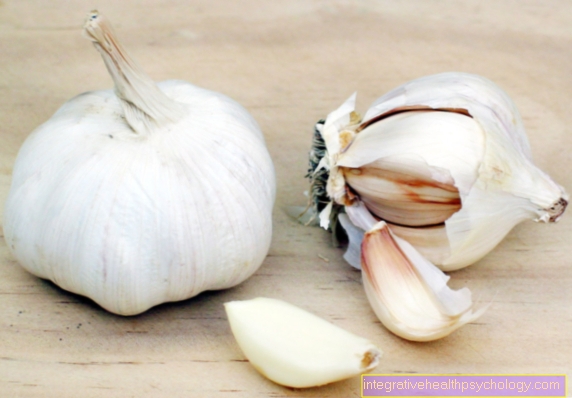

.jpg)

